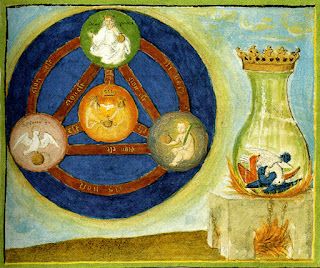The Gnostic Ophite Tetrad probably refers to the Ophite diagram in Origen, which can be interpreted variously (Contra Celsus, Book 6, Chapter 24 to 38). It looks similar to a neoplatonized version of the Ophite cosmology from Synesios (see http://www.bibliotecapleyades.net/sumer_anunnaki/reptiles/serpent_tribe/serpent_tribe08.htm ): "Male thou and female, Voice thou and silence, Nature engendered of Nature. Thou King, Aeon of Aeons, What is it lawful to call thee? Father of all Fathers, Father of thyself, Propator [Forefather] who hast no father, O Son of thyself But the initiated mind Says this and that, Celebrating with dances The Ineffable Bythos." [Hymn III]
One can find a similar Sethian/Ophite tetrad in the Nag Hammadi text, Eugnostos (See The Nag Hammadi Library, 1990, pp. 227-28) : 1- Unbegotten Forefather; 2-Self-Begetter; 3- Man of Depth; 4-Sophia. (see also Ophite Gnosticism, Sethianism and the Nag Hammadi Library, Tuomas Rasimus,Vigiliae Christianae, Vol. 59, No. 3 (Aug., 2005), pp. 235-263).
Coincidently, there's another somewhat obscure connection of the Arba-il with Gnosticism - the word 'Barbelo', has been conjectured to be derived from that term. See Wace, p. 714):
HPB gives a Babylonian example (see Rawlinson’s The Five Great Monarchies of the Ancient Eastern World, Or, The ..., Volume 2, p.15)
 |
| Ninhursag, Enki with trinity of Anu, Enlil & grandson Ninurta |
In Christian mysticism, the concept can be found with people like John of Ruusbroec and George Gichtel with the quaternary of the Father, Son, Holy Spirit and Sophia. For another example from Christian theology, one can turn to Alchemy. Jung calls this concept the ''Three and the One'' Alchemical quaternary and he cites a text by a certain Orthelius in relation to the above image (from the Rosarium philosophorum 1550 , (Jung, p. 429)):
 ''There are said to be two treasures: one is the written word and the other is the word become fact (verbum factum). In the verbum scriptum Christ is still in swaddling clothes in his cradle (in cunis suis involutus); but in the verbum dictum et factum the word is incarnate in God’s creatures, and there, in a manner of speaking, we may touch it with our hands. From them we must raise up our treasure, for the word is nothing other than the fire, the life, and the spirit which the Holy Trinity did scatter abroad from the beginning of creation, and which brooded (incubavit) on the face of the waters, and which was breathed into (inspiratus) all things by the word of God, and embodied in them, as it is written: ‘’The spirit of God filled the whole world.’’ Some have expressed the opinion that this world spirit (spiritus mundi) was the third person of the Godhead; but they have not considered the word ‘Elohim,’’ which, being plural extends to all persons of the Trinity. They say this spirit proceeded from thence and was by it created, that I became corporeal and is the chief constituent of the Saviour (salvatoris) or Philosophical Stone, and is the true medium whereby body and soul are held united during our life.'' Jung, C.G. (1968). Psychology and Alchemy, Collected Works of C.G. Jung, Volume 12, Princeton, N.J.: Princeton University Press. pp.428-29
''There are said to be two treasures: one is the written word and the other is the word become fact (verbum factum). In the verbum scriptum Christ is still in swaddling clothes in his cradle (in cunis suis involutus); but in the verbum dictum et factum the word is incarnate in God’s creatures, and there, in a manner of speaking, we may touch it with our hands. From them we must raise up our treasure, for the word is nothing other than the fire, the life, and the spirit which the Holy Trinity did scatter abroad from the beginning of creation, and which brooded (incubavit) on the face of the waters, and which was breathed into (inspiratus) all things by the word of God, and embodied in them, as it is written: ‘’The spirit of God filled the whole world.’’ Some have expressed the opinion that this world spirit (spiritus mundi) was the third person of the Godhead; but they have not considered the word ‘Elohim,’’ which, being plural extends to all persons of the Trinity. They say this spirit proceeded from thence and was by it created, that I became corporeal and is the chief constituent of the Saviour (salvatoris) or Philosophical Stone, and is the true medium whereby body and soul are held united during our life.'' Jung, C.G. (1968). Psychology and Alchemy, Collected Works of C.G. Jung, Volume 12, Princeton, N.J.: Princeton University Press. pp.428-29 |
| Brahma, Vishnu, Shiva, Devi |
To sum up, below is a chart of the concept of the mystic four that takes into account original sources that have come to light more recently. I think it remains a fairly esoteric concept, but seems to have had some noticeable presence in ancient theologies, with a deep theosophical significance and so from Rawlinson to Inman to Blavatsky and Jung, it can be considered a bona fide theme in comparative religion, with Blavatsky maintaining that there is a spiritual symbolism common to them all:
India
|
Sumerian
|
Sethian Gnostic
|
Kabbalah
|
1 - Brahma
|
An
|
Unbegotten Forefather
|
Keter
|
2 - Siva
|
Enlil
|
Self-Begetter
|
Chackmah
|
3 -Vishnu
|
Enki
|
Man of Depth
|
Binah
|
4 – Devi Mahatmya
|
Ninhursag
|
Sophia
|
Ruach Hakodesh |

No comments:
Post a Comment